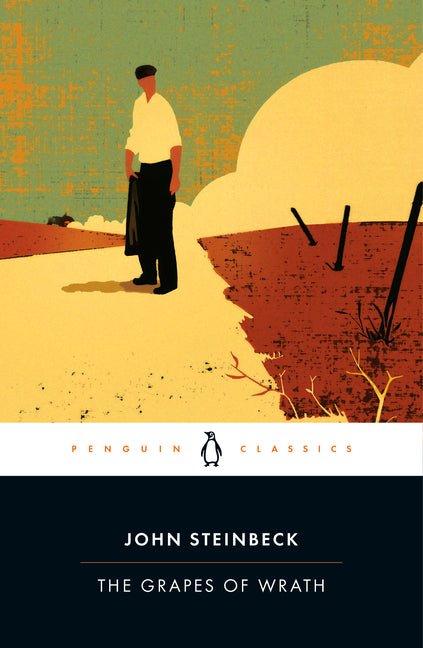Penguin Classics
The Grapes of Wrath
Couldn't load pickup availability
The Pulitzer Prize-winning epic of the Great Depression, a book that galvanized--and sometimes outraged--millions of readers. Nominated as one of America's best-loved novels by PBS's The Great American Read
A Penguin Classic
First published in 1939, Steinbeck's Pulitzer Prize-winning epic of the Great Depression chronicles the Dust Bowl migration of the 1930s and tells the story of one Oklahoma farm family, the Joads--driven from their homestead and forced to travel west to the promised land of California. Out of their trials and their repeated collisions against the hard realities of an America divided into Haves and Have-Nots evolves a drama that is intensely human yet majestic in its scale and moral vision, elemental yet plainspoken, tragic but ultimately stirring in its human dignity. A portrait of the conflict between the powerful and the powerless, of one man's fierce reaction to injustice, and of one woman's stoical strength, the novel captures the horrors of the Great Depression and probes into the very nature of equality and justice in America. At once a naturalistic epic, captivity narrative, road novel, and transcendental gospel, Steinbeck's powerful landmark novel is perhaps the most American of American Classics.
This Penguin Classics edition contains an introduction and notes by Steinbeck scholar Robert Demott.
For more than seventy years, Penguin has been the leading publisher of classic literature in the English-speaking world. With more than 1,800 titles, Penguin Classics represents a global bookshelf of the best works throughout history and across genres and disciplines. Readers trust the series to provide authoritative texts enhanced by introductions and notes by distinguished scholars and contemporary authors, as well as up-to-date translations by award-winning translators.
Share
Book Details
ISBN:
9780143039433
EAN:
9780143039433
Binding:
Paperback
Pages:
528
Authors:
John Steinbeck
Publisher:
Penguin Classics

Highly recommend this classic tale of an American experience that should not be forgotten. The Okies endured many trials in their migration west. This book does a great job in capturing their story.
I ordered it for my granddaughter.
A must read classic especially in these trying modern times and the message embedded within the story. Everyone should read this one.
Good classic book that I wanted before they took it off shelves
In the tight-knit, dust-and-dirt community of Pine Hollow, Minnesota, where the 1930s stretched long and thin for most, a girl named Marianna Lewis found solace in the world around her. At seven, she whiled away hours chasing the neighborhood children through sunlit meadows, her pockets stuffed with scraps of fabric and bits of string she’d repurpose into dolls and toys. While other kids played tag or hide-and-seek, Mari often wandered alone, sketching the curves of old barn wood or the way dandelion fluff floated like tiny parachutes in the breeze. Her friends rarely understood her quiet obsessions—when she asked to borrow a knife to carve a figure from a discarded wooden spoon, they laughed, but she didn’t mind. She was already building a world in her head, one brushstroke at a time.By her teens, the town’s hardships pressed in like the cold. Jobs were scarce, and even simple pleasures like new pencils or paper were luxuries. Mari traded chores with neighbors for art supplies: sweeping floors for a set of crayons, mending clothes in exchange for a used sketchbook. She painted on anything she could—sacks, old wallpaper, the back of newspaper clippings tucked under porch steps. During one particularly harsh winter, when the school’s heating gave out, she and a group of kids huddled in the library, sharing stories to keep warm. Mari drew their faces in the margins of a library book, capturing the way frost clung to their breath and the determination in their eyes. A passing librarian, noticing her work, slipped her a few pennies and pointed to a bulletin board advertising a distant art school, its location a whisper of possibility.Mari’s childhood was stitched with small sorrows. She watched neighbors lose homes, heard the murmur of families splitting up to survive, and felt the sting of going to school in patched clothes while others wore store-bought dresses. Yet in those struggles, she found her voice. She turned discarded objects into canvases—a tin can became a still-life study of sunlight, a broken wheel inspired a painting of motion and resilience. When other children teased her for daydreaming, she retreated into her imagination, where colors bloomed even in the grayest days.By her late teens, her work began to draw attention. A local shopkeeper, moved by a mural she painted on a faded warehouse wall, offered to sell her pieces. The sales were modest, but they bought her more supplies and kept her spirit alive. Years later, when Marianna Lewis’s name appeared in magazines and her paintings sold for sums she once couldn’t have imagined, she would recall the pinch of hunger, the ache of cold, and the neighbors who shared what little they had. Fame, she liked to say, wasn’t about talent alone—it was about learning to see beauty in the broken pieces of life and refusing to look away.Long after she left Pine Hollow, the town remembered the girl who saw art in everything, turning scarcity into a canvas for dreams.


